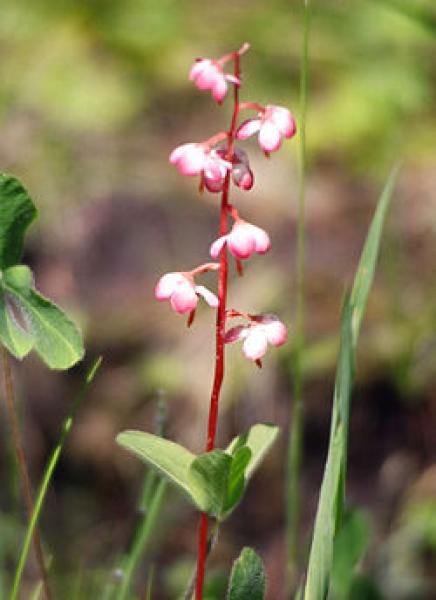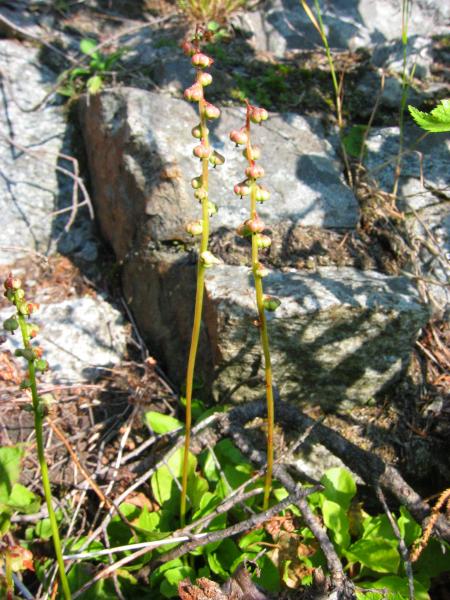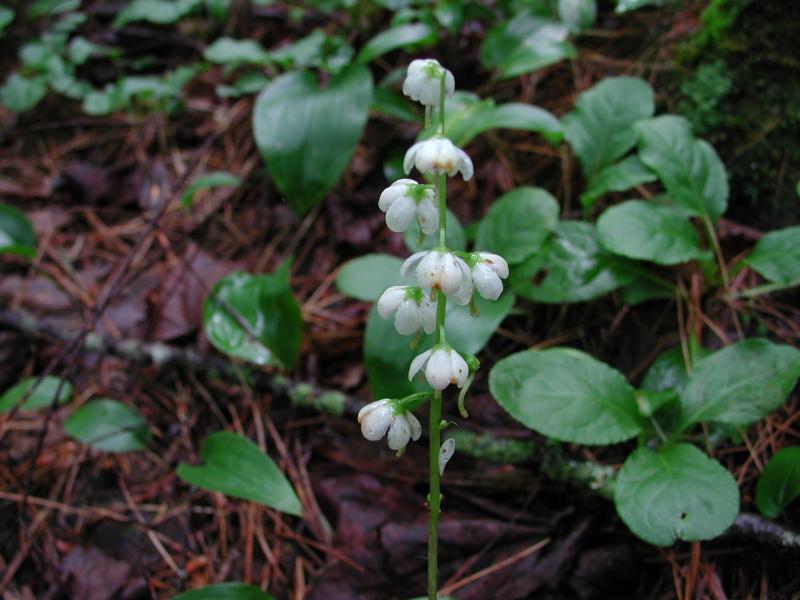Pink Shinleaf
Pyrola asarifolia ssp. asarifolia None
- Class
- Dicotyledoneae (Dicots)
- Family
- Ericaceae (Heath Family)
- State Protection
- Threatened
Listed as Threatened by New York State: likely to become Endangered in the foreseeable future. For animals, taking, importation, transportation, or possession is prohibited, except under license or permit. For plants, removal or damage without the consent of the landowner is prohibited.
- Federal Protection
- Not Listed
- State Conservation Status Rank
- S2S3
Imperiled or Vulnerable in New York - Very vulnerable, or vulnerable, to disappearing from New York, due to rarity or other factors; typically 6 to 80 populations or locations in New York, few individuals, restricted range, few remaining acres (or miles of stream), and/or recent and widespread declines. More information is needed to assign either S2 or S3.
- Global Conservation Status Rank
- G5T5
Secure globally - Both the species as a whole and the subspecies/variety are common in the world; widespread and abundant (but may be rare in some parts of its range).
Summary
Did you know?
The roots of Pink Wintergreen and other species of the genus Pyrola have symbiotic associations with soil fungi. The seeds have not been grown in artificial environments, and apparently require soils with certain fungi species present in order to germinate. "Wintergreen" refers to the evergreen basal leaves.
State Ranking Justification
There are 16 verified and 11 historical occurrences in New York.
Short-term Trends
Three new populations have been discovered in the last decade, and the other verified populations appear to be persisting.
Long-term Trends
There are at least 19 historical populations which need to be surveyed for in order to determine long-term trends in the state.
Conservation and Management
Threats
Trampling and logging are potential threats to the species at some sites in New York.
Conservation Strategies and Management Practices
Pink Wintergreen often occupies shaded, wet habitats within forested peatlands; management which maintains current conditions should benefit the species at such sites.
Habitat
Habitat
In New York, Pink Wintergreen has been found in shady habitats of northern, forested peatlands, including both rich swamps of Northern White Cedar and Black Ash and more acidic sites with black spruce and red maple (New York Natural Heritage Program 2008). Cedar swamps and other moist forests; peatlands, marl bogs, and springy places; interdunal hollows and borders of shore thickets (Voss 1996). Moist woods and bogs (Gleason and Cronquist 1991). Rich, chiefly calcareous, woods and thickets; mossy woods and swamps (chiefly calcareous (Fernald 1970). Prefers a moist sandy woodland soil in a cool position with partial shade (Runesson 2005).
Associated Ecological Communities
- Black spruce-tamarack bog*
(guide)
A conifer forest that occurs on acidic peatlands in cool, poorly drained depressions. The characteristic trees are black spruce and tamarack; in any one stand, either tree may be dominant, or they may be codominant. Canopy cover is quite variable, ranging from open canopy woodlands with as little as 20% cover of evenly spaced canopy trees to closed canopy forests with 80 to 90% cover.
- Hemlock-northern hardwood forest*
(guide)
A mixed forest that typically occurs on middle to lower slopes of ravines, on cool, mid-elevation slopes, and on moist, well-drained sites at the margins of swamps. Eastern hemlock is present and is often the most abundant tree in the forest.
- Inland poor fen
(guide)
A wetland fed by acidic water from springs and seeps. Plant remains in these fens do not decompose rapidly and thus the plants in these fens usually grow on older, undecomposed plant parts of mostly sphagnum mosses.
- Northern white cedar swamp
(guide)
A swamp that occurs on organic soils in cool, poorly drained depressions in central and northern New York, and along lakes and streams in the northern half of the state. These swamps are often spring-fed with continually saturated soils. Soils are often rich in calcium. The characteristic tree is northern white cedar, which makes up more than 30% of the canopy cover.
- Red maple-tamarack peat swamp*
(guide)
A swamp that occurs on organic soils (peat or muck) in poorly drained depressions. These swamps are often spring fed or enriched by seepage of mineral-rich groundwater resulting in a stable water table and continually saturated soil. The dominant trees are red maple and tamarack. These species usually form an open canopy (50 to 70% cover) with numerous small openings dominated by shrubs or sedges.
- Rich hemlock-hardwood peat swamp*
(guide)
A swamp that occurs in central New York in depressions or concave slopes which receive groundwater discharge. These swamps usually have a fairly open canopy (50 to 70% cover), scattered shrubs, and a diverse groundlayer with sedges, mosses, and forbs. The characteristic canopy trees are eastern hemlock (which usually have at least 20% cover), red maple, yellow birch, black ash, tamarack, white pine, smooth serviceberry, balsam fir, and northern white cedar.
- Spruce-fir swamp*
(guide)
A conifer swamp that typically occurs in a drainage basin but also can occur at the edge of a lake or pond or along gentle slopes of islands. These swamps are usually dense, with a fairly closed canopy (80 to 90% cover). The dominant tree is usually red spruce. Codominant trees include balsam fir and red maple. In the Catskills, balsam fir may be absent, and in the Adirondacks, black spruce or white spruce may replace red spruce as a dominant tree.
* probable association but not confirmed.
Associated Species
- Acer rubrum
- Anemone canadensis (Canada anemone)
- Betula alleghaniensis (yellow birch)
- Chimaphila umbellata (pipsissewa)
- Coptis trifolia (gold-thread)
- Cornus canadensis (bunchberry)
- Equisetum arvense (field horsetail, common horsetail)
- Fraxinus nigra (black ash)
- Gaultheria hispidula (snowberry)
- Larix laricina (tamarack)
- Linnaea borealis
- Maianthemum
- Mitella diphylla (two-leaved mitrewort, two-leaved bishop's-cap)
- Mitella nuda (naked mitrewort, naked bishop's-cap)
- Orthilia secunda (one-sided-wintergreen)
- Osmunda cinnamomea
- Osmunda regalis var. spectabilis (royal fern)
- Picea mariana (black spruce)
- Pilosella aurantiaca (orange hawkweed)
- Populus balsamifera (balsam poplar)
- Salix
- Sphagnum
- Thuja occidentalis (northern white cedar, arbor vitae)
- Trientalis borealis
- Veronica serpyllifolia
Range
New York State Distribution
Pink Wintergreen is known from northern regions of the state, from the St. Lawrence Seaway area and Adirondacks, south to the Capital District, Syracuse, and Buffalo areas.
Global Distribution
Pink wintergreen has a circumboreal distribution. In North America it is found throughout the boreal forest zone of Canada, south in the U.S. to the mountain west, and east to the Dakotas, the upper midwest, Pennsylvania, New York, and northern New England.
Identification Comments
General Description
Pink Wintergreen is a perennial wildflower species, with basal leaf rosettes growing from long, branched rhizomes. The basal leaves are evergreen, shiny, and leathery, 3 to 6 cm long, elliptical to kidney-shaped with fine teeth on the margins, and petioles longer than the blades. The bell-shaped flowers point downward, and are borne on a single, unbranched, central stalk, with 1 to 3 tiny or "scale" leaves. The sepals are triangular, longer than they are broad, and overlap slightly at their bases. The petals are pinkish, and 5-7 mm long.
Best Life Stage for Proper Identification
Flowering specimens are best for identification.
Similar Species
Pyrola rotundifolia has white flowers, the sepals are not overlapping at the base, and the leaf blades are rounded to nearly truncate (not cordate) at the base, often tapering onto very narrowly winged petioles. Pyrola elliptica has opaque and thin leaf blades that are usually longer than the petioles with white petals (rarely pink). Pyrola elliptica is variably and often confused with P. rotundifolia or P. asarifolia. The most reliable characteristic to distinguish P. elliptica is the bracts at the base of the pedicles which are usually less than 0.8 mm broad (rarely to 1mm) compared to P. rotundifolia/P. asarifolia which have bracts 1-3.2 mm broad.
Best Time to See
Pink Wintergreen flowers from mid-June through August.
- Flowering
The time of year you would expect to find Pink Shinleaf flowering in New York.
Pink Shinleaf Images
Images of Similar Species
Taxonomy
Pink Shinleaf
Pyrola asarifolia ssp. asarifolia None
- Kingdom Plantae
- Phylum Anthophyta
- Class Dicotyledoneae
(Dicots)
- Order Ericales
- Family Ericaceae (Heath Family)
- Order Ericales
- Class Dicotyledoneae
(Dicots)
- Phylum Anthophyta
Additional Common Names
- Pink Pyrola
- Pink Wintergreen
Synonyms
- Pyrola asarifolia var. purpurea (Bunge) Fern.
- Pyrola uliginosa Torr. & A. Gray
Additional Resources
References
Fernald, M.L. 1950. Gray's manual of botany. 8th edition. D. Van Nostrand, New York. 1632 pp.
Gleason, Henry A. and A. Cronquist. 1991. Manual of Vascular Plants of Northeastern United States and Adjacent Canada. The New York Botanical Garden, Bronx, New York. 910 pp.
Holmgren, Noel. 1998. The Illustrated Companion to Gleason and Cronquist's Manual. Illustrations of the Vascular Plants of Northeastern United States and Adjacent Canada. The New York Botanical Garden, Bronx, New York.
Kartesz, John T. 1994. A synonomized checklist of the vascular flora of the United States, Canada and Greenland. Volume 1-Checklist. Volume 2-Thesaurus.
New York Natural Heritage Program. 2010. Biotics database. New York Natural Heritage Program. New York State Department of Environmental Conservation. Albany, NY.
New York Natural Heritage Program. 2024. New York Natural Heritage Program Databases. Albany, NY.
Reschke, Carol. 1990. Ecological communities of New York State. New York Natural Heritage Program, New York State Department of Environmental Conservation. Latham, NY. 96 pp. plus xi.
Runesson, U. 2005. Herbs and Other Plant Species of the World's Boreal Forests. Faculty of Forestry and the Forest Environment Lakehead University. Thunder Bay, Ontario, CA. Last modified June 17, 2005. (Accessed 2005) www.borealforest.org.
Voss, Edward G. 1996. Michigan Flora Part III. Dicots Concluded (Pyrolaceae - Compositae). Cranbrook Institute of Science Bulletin 61 and University of Michigan Herbarium. 622 pp.
Weldy, T. and D. Werier. 2010. New York flora atlas. [S.M. Landry, K.N. Campbell, and L.D. Mabe (original application development), Florida Center for Community Design and Research http://www.fccdr.usf.edu/. University of South Florida http://www.usf.edu/]. New York Flora Association http://newyork.plantatlas.usf.edu/, Albany, New York
Links
About This Guide
Information for this guide was last updated on: December 29, 2008
Please cite this page as:
New York Natural Heritage Program. 2024.
Online Conservation Guide for
Pyrola asarifolia ssp. asarifolia.
Available from: https://guides.nynhp.org/pink-wintergreen/.
Accessed July 26, 2024.


